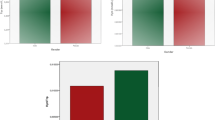Abstract
The aim of the study was to evaluate the effect of anesthetics as operating room contaminants on tetrahydrobiopterin pathway in 40 operating room personnel and 30 healthy controls by measuring biopterin, dihydrobiopterin reductase, tryptophan, kynurenine and serotonin. Biopterin concentrations were 124 ± 12.3 µmol/mol creatinine in workers and 88 ± 5.7 µmol/mol creatinine in controls whereas kynurenine concentrations were 1.75 ± 0.09 µM and 1.95 ± 0.06 µM, respectively (both, p < 0.05). It can be claimed that enhanced biopterin and diminished kynurenine levels may play a triggering role in disruption of metabolic events in operating room personnel.

Similar content being viewed by others
References
Alexander BH, Checkoway H, Nagahama BA, Domino KB (2000) Cause-specific mortality risks of anesthesiologists. Anesthesiology 93:922–930
Baydar M, Capan Z, Girgin G, Baydar T, Sahin G (2011) Evaluation of changes in immune system of operating room personnel by measurement of urinary neopterin concentrations. Pteridines 22:13–17
Byhahn C, Wilke H, Westphal K (2001) Occupational exposure to volatile anaesthetics: epidemiology and approaches to reducing the problem. CNS Drugs 15:197–215
Girgin G, Baydar T, Sahin TT, Palabiyik SS, Sipahi H, Yüksel O, Tekin E, Taneri F (2010) Urinary biopterin levels and blood dihydropteridine reductase activities in patients with thyroid and breast disorders. Pteridines 21:72–78
Gruber G, Lirk P, Amann A, Keller C, Schobersberger W, Hoffmann G, Fuchs D, Rieder J (2002) Neopterin as a marker of immunostimulation: an investigation in anaesthetic workplaces. Anaesthesia 57:747–750
Guirguis S, Pelmear P, Roy M, Wong L (1990) Health effects associated with exposure to anaesthetic gases in Ontario hospital personnel. Br J Ind Med 47:490–497
Irwin MG, Trinh T, Yao CL (2009) Occupational exposure to anaesthetic gases: a role for TIVA. Exp Opin Drug Saf 8:473–483
Laich A, Neurauter G, Widner B, Fuchs D (2002) More rapid method for simultaneous measurement of tryptophan and kynurenine by HPLC. Clin Chem 48:579–581
Maulen B (2010) Every life counts: suicide by anesthetists. Anaesthesist 59:395–400
Netter JC, Dhondt JL, Rance F, Petrus M (1991) Early neurotoxicity of high-dose of methotrexate and tetrahydrobiopterin deficiency. Arch Fr Pediatrie 48:719–722
Nilsson R, Björdal C, Andersson M, Björdal J, Nyberg A, Welin B, Willman A (2005) Health risks and occupational exposure to volatile anaesthetics—a review with a systematic approach. J Clin Nurs 14:173–186
Phoon WO (1995) Occupational medicine-Interface with toxicology. In: Stacey NH (ed) Occupational toxicology. Taylor and Francis, London, pp 295–304
Sasskortsak AM, Wheeler IP, Purdham JT (1981) Exposure of operating-room personnel to anesthetic agents—an examination of the effectiveness of scavenging systems and the importance of maintenance programs. Can Anaesth Soc J 28:22–28
Thony B, Auerbach G, Blau N (2000) Tetrahydrobiopterin biosynthesis, regeneration and functions. Biochem J 347(Pt 1):1–16
Thorn PS (2001) Occupational toxicology. In: Klaassen CD (ed) Casarett and Doull’s toxicology: the basic science of poisons, 6th edn. McGraw-Hill, New York, pp 1123–1140
Turkan H, Aydin A, Sayal A (2005) Effect of volatile anesthetics on oxidative stress due to occupational exposure. World J Surg 29:540–542
Verbeek MM, Blom AM, Wevers RA, Lagerwerf AJ, van de Geer J, Willemsen MA (2008) Technical and biochemical factors affecting cerebrospinal fluid 5-MTHF, biopterin and neopterin concentrations. Mol Genet Metab 95:127–132
Wei CC, Crane BR, Stuehr DJ (2003) Tetrahydrobiopterin radical enzymology. Chem Rev 103:2365–2383
Werner ER, Blau N, Thony B (2011) Tetrahydrobiopterin: biochemistry and pathophysiology. Biochem J 438:397–414
Wood C, Ewen A, Goresky G (1992) Exposure of operating room personnel to nitrous oxide during paediatric anaesthesia. Can J Anaesth 39:682–686
www.nlm.nih.gov/medlineplus/ency/article/003562.htm Serum serotonin level. Accessed 01 Feb 2012
Author information
Authors and Affiliations
Corresponding author
Rights and permissions
About this article
Cite this article
Baydar, M., Capan, Z., Girgin, G. et al. Evaluation of Tetrahydrobiopterin Pathway in Operating Room Workers: Changes in Biopterin Status and Tryptophan Metabolism. Bull Environ Contam Toxicol 89, 1125–1128 (2012). https://doi.org/10.1007/s00128-012-0845-y
Received:
Accepted:
Published:
Issue Date:
DOI: https://doi.org/10.1007/s00128-012-0845-y




